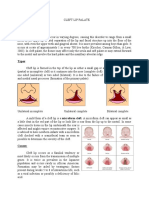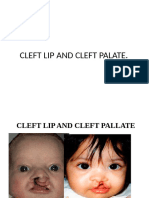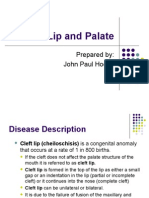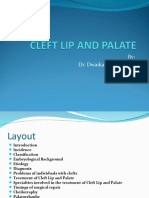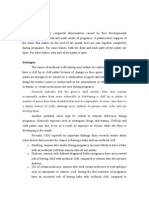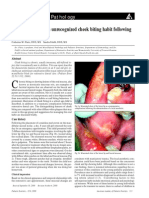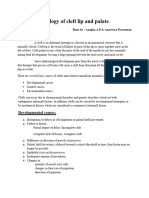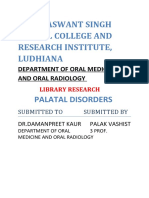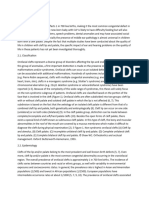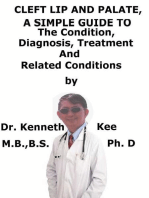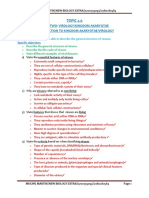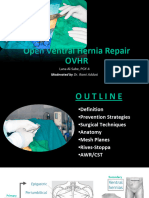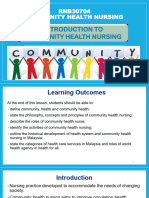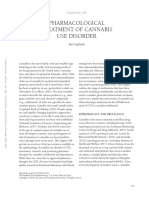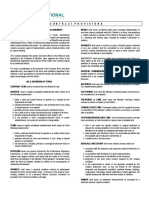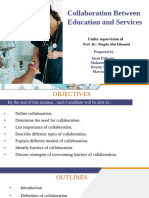Oral Development Pathology
Oral Development Pathology
Uploaded by
KathyWCopyright:
Available Formats
Oral Development Pathology
Oral Development Pathology
Uploaded by
KathyWOriginal Description:
Copyright
Available Formats
Share this document
Did you find this document useful?
Is this content inappropriate?
Copyright:
Available Formats
Oral Development Pathology
Oral Development Pathology
Uploaded by
KathyWCopyright:
Available Formats
REVIEWS AND CONTEMPORARY UPDATES
Ochsner Journal 18:339–344, 2018
© Academic Division of Ochsner Clinic Foundation
DOI: 10.31486/toj.18.0040
Oral Development and Pathology
Melinda B. Clark, MD, FAAP, David A. Clark, MD, FAAP
Department of Pediatrics, Albany Medical Center, Albany, NY
Background: The mouth is integral in the development of feeding, the initiation of digestion, and for speech and socialization.
Signs of systemic disease and nutritional deficiencies often manifest in the mouth, and poor oral health can exacerbate many
systemic conditions.
Methods: This review addresses the fetal development of the mouth, major anomalies, common minor physical findings, and
pathologic conditions and their management.
Results: Pediatric practitioners have historically been poorly trained in diagnosis and management of oral conditions, so this
article provides an overview of oral embryology and pathology, with a focus on hard and soft tissue disease identification,
triage, and management. For primary prevention to be effective, pediatric providers must be knowledgeable about the
process of dental caries, prevention of the disease, and available interventions, including fluoride.
Conclusion: The embryology and anatomy of the oral cavity are complex, and the mouth is crucial to many physiologic
processes. Pediatric primary care providers are uniquely positioned to prevent, identify, and triage dental caries, the most
common chronic disease of childhood.
Keywords: Abnormalities–mouth, dental caries, odontogenesis, pathology–oral
Address correspondence to David A. Clark, MD, FAAP, Department of Pediatrics, Albany Medical Center, 47 New Scotland Ave., Albany,
NY 12208. Tel: (518) 262-5333. Email: clarkd@amc.edu
INTRODUCTION ate the posterior hard palate as the soft palate and the uvula
The mouth reflects general health and well-being, such fuse during gestation weeks 10 to 12. Cleft lip and palate are
that you cannot “be healthy without a healthy mouth.”1 common congenital anomalies with a prevalence of 17 per
The mouth is where taste and chewing occur and is integral 10,000 live births.4 The etiology of clefts remains poorly un-
to digestion, respiration, speech, and socialization; it is also derstood, although genetic, syndromic, and environmental
a mirror reflecting systemic processes and health. Signs of factors have all been implicated. Cleft lip can be unilateral,
systemic disease and nutritional deficiencies often manifest bilateral (Figure 2), or median or of only the soft palate (mu-
in the mouth, and poor oral health can exacerbate many sys- cous cleft), although midline lip cleft is rare. Isolated cleft
temic conditions. Pediatric practitioners have historically palate is more common in females with no racial predilec-
been poorly trained in diagnosis and management of oral tion.4 Cleft lip with palate is twice as common as isolated
conditions, so this article provides an overview of oral em- cleft palate, with an incidence greater in males and those
bryology and pathology, with a focus on hard and soft tissue of Asian and Caucasian descent. Cleft palate without cleft
disease identification, triage, and management. lip is more likely to be associated with a syndrome.3
Teratogen exposures implicated in cleft development in-
OROFACIAL DEVELOPMENT clude organic solvents and agriculture chemicals, especially
The structures of the oral cavity derive from the first bran- pesticides,5 as well as viral infections, metabolic derange-
chial arch. By the end of the fourth week of development, the ment, and illicit drugs. Antiepileptic medications associated
frontonasal, 2 maxillary, and 2 mandibular processes are vis- with orofacial defects include diazepam, phenytoin, pheno-
ible. The face and palate complete midline fusion between 6 barbital, topiramate, and lamotrigine.5-7 Nutritional deficien-
and 12 weeks’ gestation, and the upper lip fuses by 6 cies in early pregnancy are also associated with increased
weeks’ gestation.2 cleft risk, the best known being folic acid, which is now rec-
Failure of midline fusion during embryogenesis results in ommended as a routine supplement in pregnancy.8 Supple-
the spectrum of cleft lip, cleft palate, cleft lip and palate, mentation is most beneficial early in the first trimester, with a
and mucous cleft palate (Figure 1). The medial nasal tissues reduction in midline defect rates by two-thirds in babies with-
fuse to form the lip during weeks 5 to 6 of embryonic devel- out a major chromosomal anomaly.9
opment; the anterior hard palate, alveolus, and philtrum Cleft lip and/or palate is associated with many genetic
form during weeks 6 to 10.3 The maxillary prominences cre- syndromes, including the spectrum of chromosome 22q11,
Volume 18, Number 4, Winter 2018 339
Oral Development and Pathology
Figure 1. Mucous cleft palate.
oral-facial-digital syndrome, Treacher Collins syndrome, tri-
Figure 3. Trisomy 13 protruding cleft lip.
somy 13 (Figure 3), and Van der Woude syndrome.10 Cleft
palate can also result from embryonic tongue mechanical in-
terference with palatal fusion, usually stemming from micro- SOFT TISSUE ANOMALIES
gnathia with mandibular hypoplasia, known as Robin Congenital soft tissue lesions of the oral cavity are quite
sequence or Pierre Robin syndrome. common, and practitioners must be able to distinguish nor-
Care of the neonate with cleft lip and/or palate requires mal findings from those that require intervention. Epithelial
genetic and hearing assessment, as well as airway evalua- tissue remnants form oral inclusion cysts13 that are small
tion and aggressive feeding support.11 Surgical primary lip white or translucent papules or cysts seen in 75% of term
repair is often undertaken around 3 months of age and pri- newborns, although less commonly in premature infants.9
mary palatal repair around 9 months. Residual hypernasal Asymptomatic inclusion cysts require no further evaluation
speech and language delays are common following com- or management and typically resolve by 3 months of age. In-
pletion of all surgeries. Optimal management is attained clusion cysts are classified by their location. Epstein pearls,
through a multidisciplinary cleft and craniofacial team com- the most common of the 3 types, are found along the mid-
prised of experienced members of the medical, surgical, line raphe of the hard palate in 75%-80% of all neonates.14
dental, and allied health disciplines. Bohn nodules are heterotopic salivary gland remnants
Submucosal cleft palate is a mild or incomplete form of cleft seen on the buccal or lingual mucosal surface of the alveolar
palate. Examination may reveal a bifid uvula, muscular defect ridge (not the crest) or on the hard palate away from the
with overlying membrane, or a bluish mucosal line the length raphe (Figure 4). Dental lamina cysts are heterotopic sali-
of the soft palate.12 Submucosal cleft palate is clinically chal- vary gland remnants located on the crest of the alveolar
lenging to detect but is often functionally significant, as the le- ridge.
vator muscles must interdigitate across the palate to form the
normal levator sling. The levator muscle must elevate to re- ANKYLOGLOSSIA
tract the posterior soft palate and divide the nasal and oral Ankyloglossia (tongue-tie) is anchoring of the tongue an-
pharynxes to prevent velopharyngeal incompetence, which teriorly. The frenulum connects near the tip of the tongue,
adversely impacts both feeding and speech. limiting tongue extension to the lips or roof of the mouth,
Figure 2. Bilateral cleft lip and palate. Figure 4. Bohn nodules.
340 Ochsner Journal
Clark, MB
with a notched or heart-shaped tongue on protrusion. Anky-
loglossia has a prevalence of 4%-10% but varies in severity
and clinical impact, resulting in considerable debate regard-
ing optimal management.15 Restricted tongue movement
can lead to a variety of problems in infants and children, in-
cluding challenges with breastfeeding latch, articulation
delay, and compromised oral health.16,17
Initial symptoms of ankyloglossia include maternal nipple
pain with breastfeeding, loss of suction, clicking sound while
feeding, poor latch, and suboptimal milk transfer.18 Signifi-
cant ankyloglossia can also contribute to articulation chal-
lenges but not a delay in absolute word production.19 Oral
hygiene may be compromised with ankyloglossia, increas-
ing the risk of dental caries and periodontal disease.
Management of ankyloglossia-related breastfeeding diffi-
culties should include lactation specialist consultation, but Figure 5. Natal tooth.
frenectomy has been shown to improve breastfeeding for
mother and newborn better than intensive lactation support
alone.20 Indications and timing of surgical division for anky- syndromes of chondroectodermal dysplasia (Ellis-van
loglossia have been investigated, and in one randomized, Creveld syndrome) and oculomandibulofacial syndrome
prospective, unblinded trial of neonates with ankyloglossia (Hallermann-Streiff syndrome).26
and feeding concerns, all infants who received immediate Humans develop 2 sets of teeth, classifying us as diphy-
division of the frenulum showed breastfeeding improve- odont. The primary dentition begins developing in utero at
ment, but only one neonate in the control group (intensive week 8 of gestation, and the first primary teeth emerge be-
lactation support) improved. Frenotomy was then offered tween 6 and 12 months of age. The primary dentition is a
to and performed for the infants in the control group, and complete set of 20 teeth by age 3 and consists of 8 incisors,
all but one baby improved and fed normally after the proce- 4 canines, and 8 molars. Primary teeth begin exfoliation at
dure.20 Frenotomy can be performed with blunt scissors, around 6 years of age, forced out by eruption of the perma-
cautery, or laser if a simple membrane is present, but frenu- nent teeth. The permanent dentition consists of 32 teeth: 8
loplasty is preferred for more complex anatomy.21 Ankylo- incisors, 4 canines, 8 premolars, and 12 total molars in 4
glossia is typically not indicative of underlying genetic sets of 3. The usual pattern of molar eruption is first molars
syndrome, but absence of the inferior labial frenum and lin- between 6 and 8 years of age, second molars between ages
gual frenulum is commonly noted in Ehlers-Danlos syn- 11 to 13 years, and third molars, or wisdom teeth, between
drome, and absence of the inferior labial frenum is ages 17 and 21 years.
strongly correlated with infantile hypertrophic pyloric steno- Human teeth contain 4 distinct types of tissue: pulp, den-
sis.22 tin, enamel, and cementum. The outermost layer of the tooth
Management of a constricted maxillary frenum is even is made of enamel, the hardest tissue in the body, that with-
more controversial. The maxillary frenum normally extends stands mechanical and thermal insults and protects against
over the alveolar ridge to form a raphe. Persistence of the infection. Under the thin layer of enamel is dentin, the yellow
raphe during dental eruption can lead to diastema, or widely substance forming the bulk of the tooth mass. The inner-
spaced central incisors. A prominent maxillary labial frenum most portion of the tooth is the pulp, containing nerves
may lead to esthetic concerns and to difficulty with plaque and blood vessels that enter the root through a small hole
control which potentiates dental caries risk. Maxillary frenec- in the tip. Teeth are held in place in the maxilla and mandible
tomy is clearly indicated in rare cases when the frenum at- bones by a layer of cementum that covers the root.
tachment exerts tension on the gingiva of a permanent
tooth or if cosmesis is unacceptable following orthodontic DENTAL CARIES
closure of the diastema.23 Additional research is needed to Dental caries, also known as tooth decay, is the most com-
better understand the appropriateness of performing pre- mon chronic disease of childhood,1 with 25% of children
ventive maxillary frenectomy on young children. ages 2-5 years27 and 59% of teenagers having at least 1
documented cavity.28 Most adults develop cavities and, of
DENTAL DEVELOPMENT AND DISEASE great public health concern, nearly 25% of adults 20-64
Humans are usually born edentulous, but tooth eruption years have untreated dental caries.29 Dental caries in the pri-
may occur before birth (natal teeth) or within the first mary teeth of children under 6 years of age is now termed
month of life (neonatal teeth) at a rate of 1:2,000 to early childhood caries (ECC), encompassing the previous
1:3,000 live births (Figure 5).24 Central mandibular incisors nomenclature of nursing caries and baby bottle tooth
are most likely to prematurely erupt; these are usually prima- decay. ECC is a multifactorial disease resulting from the inter-
ry dentition and not extra teeth,25 so they should not be ex- action of cariogenic microorganisms and fermentable carbo-
tracted without cause. Management is usually observation, hydrates but impacted by a wide range of social variables.30
although extraction may be considered if teeth are mobile At the most basic level, dental caries requires 4 compo-
and present an aspiration risk, interfere with breastfeeding, nents: teeth, bacteria, carbohydrate exposure, and time.
or cause Riga-Fede ulceration.25 Natal teeth are most com- Teeth become colonized with cariogenic bacteria once
monly an isolated finding but can be associated with genetic they emerge. The bacteria metabolize carbohydrates and
Volume 18, Number 4, Winter 2018 341
Oral Development and Pathology
create acid as a byproduct. The acid dissolves, or deminer- health assessments at routine visits through the age of 6
alizes, the enamel and eventually wears away the enamel years.41 Screening oral examinations are most easily con-
surface to create a hole in the tooth, termed a cavity. Once ducted in the knee-to-knee position with the child sitting fac-
a cavity has formed, the bacteria can proceed through the ing the caregiver and lying back on the lap of the examiner.
outer tooth and into the pulp, resulting in pulpitis or abscess. The oral examination should include visualization of all the
If the infection is not contained and the tooth definitively hard and soft tissues, with focus on the teeth for enamel de-
treated, the dental abscess can progress to osteomyelitis fects, presence of plaque, white spot lesions, overt decay,
of the jaw or spread to any contiguous soft tissue (face, and gingival health. For primary prevention to be effective,
neck, deep pharyngeal space, or brain) or the blood. pediatric providers must be knowledgeable about the pro-
Dental caries is a silent epidemic that disproportionately cess of dental caries, prevention of the disease, and avail-
affects those from the lower socioeconomic strata, those at able interventions, including fluoride.
the extremes of age, and minorities.31 Untreated tooth decay Fluoride is effective in cavity prevention with 3 main effects
leads to pain, interrupted sleep, inappropriate use of over- of enhancing enamel remineralization, inhibiting demineral-
the-counter medications, difficulty with chewing and eating, ization, and inhibiting bacterial metabolism, thereby limiting
and increased hospitalizations resulting from infectious acid production. The beneficial effect of fluoride is obtained
complications.31 Dental caries in the United States is re- by topical administration. Fluoride can be applied to tooth
sponsible for many school and work hours lost per year32 surfaces via fluoridated toothpaste, mouth rinses, fluoridated
and contributes to poor school performance.27 Good oral community water, dietary fluoride supplements, and fluoride
health is a necessary part of overall health, and studies varnish. The United States Preventive Services Task Force
have demonstrated the adverse effects of poor oral health (USPSTF) recommended in 2014 that primary care clinicians
on multiple other chronic conditions, including diabetes con- apply fluoride varnish to the primary teeth of all infants and
trol.33 Therefore, failure to prevent dental disease has health, children starting at the age of primary tooth eruption.42,43
educational, and financial consequences at the individual, The USPSTF made this recommendation a grade B recom-
family, and societal levels. mendation; thus, the service must be covered by the Afford-
Risk factors for ECC include having a mother/primary able Care Act and commercial payers without cost sharing.
caregiver with active cavities,34 frequent consumption of The 2014 American Academy of Pediatrics clinical report
sugary beverages and snacks, using a bottle at bedtime
“Fluoride Use in Caries Prevention in the Primary Care Set-
or through the night, prolonged frequent exposure to sugary
ting” provides a review of fluoride modalities, including rec-
liquids throughout the day,35 exposure to environmental to-
ommending fluoride varnish application in the medical home
bacco smoke,36 having special healthcare needs, xerosto-
2-4 times per year for all children ages 5 and under.44 Oral
mia, and insufficient fluoride exposure.37 Examination
health recommendations for screening, fluoride varnish,
findings that increase the risk for development of ECC in-
and fluoride supplements were added to the Bright Futures
clude visible plaque on the teeth and the presence of enam-
periodicity schedule in 2015.45
el hypoplasia. The most significant population-based risk
In June 2015, the Cochrane Oral Health group questioned
factors are low socioeconomic status and low education
the fluoridation of public water sources, especially in terms
and health literacy levels.38,39
of its effectiveness for adults. The group asserted that
Protective factors that aid in enamel remineralization in-
older studies were poorly controlled and that more research
clude exposing the teeth to fluoride, limiting the frequency
is necessary.46 In a letter to healthcare professionals dated
of carbohydrate consumption, choosing less cariogenic
foods, practicing good oral hygiene, receiving regular dental July 2, 2015,47 Katherine Weno, DDS, Director of the Division
care, and delaying bacterial colonization.37 If carious lesions of Oral Health, Centers for Disease Control and Prevention
are identified at the early white spot stage, the process can (CDC), responded forcefully in favor of water fluoridation,
be halted or even reversed by modifying the individual’s risk with her position supported by multiple studies.48-51 Five
and protective factors. days later, the American Dental Association reinforced the
Dental caries is preventable with proper oral hygiene, a position of the CDC.52
healthy diet, appropriate use of fluoride, and access to pre-
ventive dental services. All children should establish a dental CONCLUSION
home by or around their first birthday, a recommendation The embryology and anatomy of the oral cavity are com-
supported by the American Academy of Pediatrics, Ameri- plex, and the mouth is crucial to many physiologic process-
can Academy of Pediatric Dentistry, American Dental Asso- es. This review focused on common developmental and
ciation, and American Public Health Association.27,37,39 acquired defects: the spectrum of cleft lip and palate, soft
Despite these recommendations, the Medical Expenditure tissue anomalies, ankyloglossia, and the most common dis-
Panel Survey revealed that 89% of infants and 1-year-olds ease of the hard tissues, dental caries. Historically, pediatric
have office-based physician visits annually, compared with professionals have maintained ownership of soft tissue dis-
only 1.5% having dental visits.40 Because many children ease management, but this review highlights why and how
do not receive dental care at young ages, and risk factors pediatric primary care providers are uniquely positioned to
for dental caries are influenced by parenting practices, pedi- prevent, identify, and triage dental caries, which remains
atric primary care providers have a unique opportunity to the most common chronic disease of childhood.
participate in prevention of dental caries. The American
Academy of Pediatrics recommends that primary care pro- ACKNOWLEDGMENTS
viders perform oral health assessments on all children start- The authors have no financial or proprietary interest in the
ing at 6 months of age and recommends continued oral subject matter of this article.
342 Ochsner Journal
Clark, MB
REFERENCES 18. Messner AH, Lalakea ML. The effect of ankyloglossia on speech
1. Department of Health and Human Services. Oral health in in children. Otolaryngol Head Neck Surg. 2002 Dec;127(6):539-
America: a report of the surgeon general. Rockville, MD: 545.
National Institute of Dental and Craniofacial Research, National 19. Ballard JL, Auer CE, Khoury JC. Ankyloglossia: assessment,
Institutes of Health; 2000. https://profiles.nlm.nih.gov/ps/access incidence, and effect of frenuloplasty on the breastfeeding
/NNBBJT.pdf. Accessed September 5, 2018. dyad. Pediatrics. 2002 Nov;110(5):e63.
2. Moore LM, Persaud TVN. The Developing Human: Clinically 20. Buryk M, Bloom D, Shope T. Efficacy of neonatal release of
Oriented Embryology. 8th ed. Philadelphia, PA: Saunders; 2008. ankyloglossia: a randomized trial. Pediatrics. 2011 Aug;128
3. Mai CT, Cassell CH, Meyer RE, et al; National Birth Defects (2):280-288. doi: 10.1542/peds.2011-0077.
Prevention Network. Birth defects data from population-based 21. Devishree, Gujjari SK, Shubhashini PV. Frenectomy: a review
birth defects surveillance programs in the United States, 2007- with the reports of surgical techniques. J Clin Diagn Res. 2012
2011: highlighting orofacial clefts. Birth Defects Res A Clin Mol Nov;6(9):1587-1592. doi: 10.7860/JCDR/2012/4089.2572.
Teratol. 2014 Nov;100(11):895-904. doi: 10.1002/bdra.23329. 22. De Felice C, Toti P, Di Maggio G, Parrini S, Bagnoli F. Absence of
4. Canfield MA, Honein MA, Yuskiv N, et al. National estimates and the inferior labial and lingual frenula in Ehlers-Danlos
race/ethnic-specific variation of selected birth defects in the syndrome. Lancet. 2001 May 12;357(9267):1500-1502.
United States, 1999-2001. Birth Defects Res A Clin Mol Teratol. 23. American Academy of Pediatric Dentistry. Council on Clinical
2006 Nov;76(11):747-756. Affairs. Guideline on Pediatric Oral Surgery. Revised 2014.
5. Chevrier C, Dananché B, Bahuau M, et al. Occupational 24. Cunha RF, Boer FA, Torriani DD, Frossard WT. Natal and
exposure to organic solvent mixtures during pregnancy and neonatal teeth: review of the literature. Pediatr Dent. 2001 Mar-
the risk of non-syndromic oral clefts. Occup Environ Med. 2006 Apr;23(2):158-162.
Sep;63(9):617-623. 25. Bodenhoff J, Gorlin RJ. Natal and neonatal teeth: folklore and
6. Yang W, Carmichael SL, Roberts EM, et al. Residential fact. Pediatrics. 1963 Dec;32(6):1087-1093.
agricultural pesticide exposures and risk of neural tube defects 26. Hattab FN, Yassin OM, Sasa IS. Oral manifestations of Ellis-van
and orofacial clefts among offspring in the San Joaquin Valley Creveld syndrome: report of two siblings with unusual dental
of California. Am J Epidemiol. 2014 Mar 15;179(6):740-748. doi: anomalies. J Clin Pediatr Dent. 1998 Winter;22(2):159-165.
10.1093/aje/kwt324. 27. Centers for Disease Control and Prevention, National Center for
7. Anderka M, Mitchell AA, Louik C, Werler MM, Hernández-Diaz S, Chronic Disease Prevention and Health Promotion. Oral Health
Rasmussen SA; National Birth Defects Prevention Study. at a Glance: 2016. U.S. Department of Health and Human
Medications used to treat nausea and vomiting of pregnancy Services. www.cdc.gov/chronicdisease/resources/publications
and the risk of selected birth defects. Birth Defects Res A Clin /aag/oral-health.htm. Accessed September 11, 2018.
Mol Teratol. 2012 Jan;94(1):22-30. doi: 10.1002/bdra.22865. 28. Tomar SL, Reeves AF. Changes in the oral health of US children
8. Sarmah S, Muralidharan P, Marrs JA. Common congenital and adolescents and dental public health infrastructure since
anomalies: environmental causes and prevention with folic the release of the Healthy People 2010 Objectives. Acad
acid containing multivitamins. Birth Defects Res C Embryo Pediatr. 2009 Nov-Dec;9(6):388-395. doi: 10.1016/j.
Today. 2016 Sep;108(3):274-286. doi: 10.1002/bdrc.21138. acap.2009.09.018.
9. De-Regil LM, Peña-Rosas JP, Fernández-Gaxiola AC, Rayco- 29. Dye BA, Thornton-Evans G. Trends in oral health by poverty
Solon P. Effects and safety of periconceptional oral folate status as measured by Healthy People 2010 Objectives. Public
supplementation for preventing birth defects. Cochrane Health Rep. 2010 Nov-Dec;125(6):817-830.
Database Syst Rev. 2015 Dec 14;(12):CD007950. doi: 10.1002/ 30. Fisher-Owens SA, Gansky SA, Platt LJ, et al. Influences on
14651858.CD007950.pub3. children’s oral health: a conceptual model. Pediatrics. 2007
10. Jones KL. Recognizable patterns of malformation. In: Jones KL, Sep;120(3):e510-e520.
Jones JC, Del Campo M, eds. Smith’s Recognizable Patterns of 31. Casamassimo PS, Thikkurissy S, Edelstein BL, Maiorini E. Beyond
Human Malformation. 7th ed. Philadelphia, PA: Elsevier the dmft: the human and economic cost of early childhood
Saunders; 2013:318-319. caries. J Am Dent Assoc. 2009 Jun;140(6):650-657.
11. Tighe D, Petrick L, Cobourne MT, Rabe H. Cleft lip and palate: 32. Jackson SL, Vann WF Jr, Kotch JB, Pahel BT, Lee JY. Impact of
effects on neonatal care. NeoReviews. 2011 Jun;12(6):e315- poor oral health on children’s school attendance and
e324. performance. Am J Public Health. 2011 Oct;101(10):1900-1906.
12. Abbott MA. Cleft lip and palate. Pediatr Rev. 2014 May;35 doi: 10.2105/AJPH.2010.200915.
(5):177-181. doi: 10.1542/pir.35-5-177. 33. Mealey BL. Periodontal disease and diabetes. A two-way street.
13. Hayes PA. Hamartomas, eruption cyst, natal tooth and Epstein J Am Dent Assoc. 2006 Oct;137 Suppl:26S-31S.
pearls in a newborn. ASDC J Dent Child. 2000 Sep-Oct;67(5):365- 34. Douglass JM, Li Y, Tinanoff N. Association of mutans
368. streptococci between caregivers and their children. Pediatr
14. Donley CL, Nelson LP. Comparison of palatal and alveolar cysts Dent. 2008 Sep-Oct;30(5):375-387.
of the newborn in premature and full-term infants. Pediatr 35. Tinanoff N, Palmer CA. Dietary determinants of dental caries
Dent. 2000 Jul-Aug;22(4):321-324. and dietary recommendations for preschool children. J Public
15. Messner AH, Lalakea ML. Ankyloglossia: controversies in Health Dent. 2000 Summer;60(3):197-206; discussion 207-209.
management. Int J Pediatr Otorhinolaryngol. 2000 Aug 31;54(2- 36. B Hasmun NN, Drummond BK, Milne T, Cullinan MP, Meldrum
3):123-131. AM, Coates D. Effects of environmental tobacco smoke on the
16. Hogan M, Westcott C, Griffiths M. Randomized, controlled trial oral health of preschool children. Eur Arch Paediatr Dent. 2017
of division of tongue-tie in infants with feeding problems. J Dec;18(6):393-398. doi: 10.1007/s40368-017-0308-6.
Paediatr Child Health. 2005 May-Jun;41(5-6):246-250. 37. Section on Oral Health. Maintaining and improving the oral
17. Lalakea ML, Messner AH. Ankyloglossia: does it matter? Pediatr health of young children. Pediatrics. 2014 Dec;134(6):1224-
Clin North Am. 2003 Apr;50(2):381-397. 1229. doi: 10.1542/peds.2014-2984.
Volume 18, Number 4, Winter 2018 343
Oral Development and Pathology
38. Fontana M. The clinical, environmental, and behavioral factors 46. Iheozor-Ejiofor Z, Worthington HV, Walsh T, et al. Water
that foster early childhood caries: evidence for caries risk fluoridation for the prevention of dental caries. Cochrane
assessment. Pediatr Dent. 2015 May-Jun;37(3):217-225. Database Syst Rev. 2015 Jun;(6):CD010856. doi: 10.1002/
39. Congiu G, Campus G, Lugliè PF. Early childhood caries (ECC) 14651858.CD010856.pub2.
prevalence and background factors: a review. Oral Health Prev 47. Weno K. Comments regarding the Cochrane Review of Water
Dent. 2014;12(1):71-76. doi: 10.3290/j.ohpd.a31216. Fluoridation for the Prevention of Dental Caries. Department of
40. Stearns SC, Rozier RG, Kranz AM, Pahel BT, Quiñonez RB. Cost- Health and Human Services, Centers for Disease Control and
effectiveness of preventive oral health care in medical offices Prevention. July 2, 2015. http://www.ada.org/~/media/ADA
for young Medicaid enrollees. Arch Pediatr Adolesc Med. 2012 /Public%20Programs/Files/FL-CDC-Comments-Cochrane
Oct;166(10):945-951. -Review.ashx. Accessed September 7, 2018.
41. American Academy of Pediatrics, Bright Futures Steering 48. Rugg-Gunn AJ, Do L. Effectiveness of water fluoridation in
Committee. Promoting oral health. In: Hagan JF, Shaw JS, caries prevention. Community Dent Oral Epidemiol. 2012 Oct;40
Duncan PM, eds. Bright Futures: Guidelines for Health Supervision Suppl 2:55-64. doi: 10.1111/j.1600-0528.2012.00721.x.
of Infants, Children, and Adolescents. 3rd ed. Elk Grove Village, IL: 49. Brunelle JA, Carlos JP. Recent trends in dental caries in U.S.
American Academy of Pediatrics; 2008:155-168. children and the effect of water fluoridation. J Dent Res. 1990
42. Final summary: dental caries in children from birth through age Feb;69 Spec No:723-727.
5 years: screening. U.S. Preventive Services Task Force. www 50. Griffin SO, Regnier E, Griffin PM, Huntley V. Effectiveness of
.uspreventiveservicestaskforce.org/Page/Document fluoride in preventing caries in adults. J Dent Res. 2007 May;86
/UpdateSummaryFinal/dental-caries-in-children-from-birth (5):410-415.
-through-age-5-years-screening. Released May 2014. Accessed 51. Slade GD, Sanders AE, Do L, Roberts-Thompson K, Spencer AJ.
September 5, 2018. Effects of fluoridated drinking water on dental caries in
43. U.S. Department of Health and Human Services Federal Panel Australian adults. J Dent Res. 2013 Apr;92(4):376-382. doi:
on Community Water Fluoridation. U.S. public health service 10.1177/0022034513481190.
recommendation for fluoride concentration in drinking water 52. The American Dental Association responds to Cochrane Review
for the prevention of dental caries. Public Health Rep. 2015 Jul- of Water Fluoridation [press release]. July 7, 2015. https://www
Aug;130(4):318-331. .ada.org/en/press-room/news-releases/2015-archive/july/the
44. Clark MB, Slayton RL; Section on Oral Health. Fluoride use in -american-dental-association-responds-to-cochrane-review-of
caries prevention in the primary care setting. Pediatrics. 2014 -water-fluoridation. Accessed September 7, 2018.
Sep;134(3):626-633. doi: 10.1542/peds.2014-1699.
45. Hagan JF, Shaw JS, Duncan PM, eds. Bright Futures: Guidelines
for Health Supervision of Infants, Children, and Adolescents. 4th
ed. Elk Grove Village, IL: American Academy of Pediatrics; 2017.
This article meets the Accreditation Council for Graduate Medical Education and the American Board of Medical
Specialties Maintenance of Certification competencies for Patient Care, Medical Knowledge, and Practice-Based
Learning and Improvement.
344 Ochsner Journal
You might also like
- A Case Study About Cleft Lip and Cleft PalateDocument12 pagesA Case Study About Cleft Lip and Cleft PalateMaegan Pearl86% (7)
- Cleft Lip and PalateDocument34 pagesCleft Lip and PalateatikaNo ratings yet
- Kliegman: Nelson Textbook of Pediatrics, 18th Ed.: 2007 Saunders, An Imprint of ElsevierDocument14 pagesKliegman: Nelson Textbook of Pediatrics, 18th Ed.: 2007 Saunders, An Imprint of ElseviermelindamentariNo ratings yet
- Cleft Lip and Cleft PalateDocument12 pagesCleft Lip and Cleft PalateNadieya SafiyaNo ratings yet
- Cleft and Lip PalateDocument6 pagesCleft and Lip PalateShane PangilinanNo ratings yet
- Cleft LipDocument5 pagesCleft LipGrazieNo ratings yet
- Cleft Palate and LipDocument35 pagesCleft Palate and LipIddrisu Mohammed AminNo ratings yet
- Orthodontic Lect 28Document6 pagesOrthodontic Lect 28Humam ThammerNo ratings yet
- Cleft Lip and PalateDocument115 pagesCleft Lip and PalateDavid OdhiamboNo ratings yet
- Cleft Lip and Palate New ApproachDocument115 pagesCleft Lip and Palate New ApproachsoorajNo ratings yet
- MUUUDocument12 pagesMUUUKiran SNNo ratings yet
- Cleft Lip and Palate - PPT - OrthodonticsDocument46 pagesCleft Lip and Palate - PPT - OrthodonticsDr.Neethu Salam100% (5)
- Cleft Lip and Palate NewDocument7 pagesCleft Lip and Palate NewUday Kumar0% (1)
- EJMCM - Volume 7 - Issue 10 - Pages 470-474Document5 pagesEJMCM - Volume 7 - Issue 10 - Pages 470-474Ayu Nur FadilahNo ratings yet
- Developmental Disturbances of The JawsDocument52 pagesDevelopmental Disturbances of The JawsMaydis stigmaNo ratings yet
- Case Study CPLDocument7 pagesCase Study CPLSkyllen FhayeNo ratings yet
- Cleft Lip and PalateDocument83 pagesCleft Lip and Palategracy david0% (1)
- A Case Study About Cleft Lip and Cleft PalateDocument12 pagesA Case Study About Cleft Lip and Cleft PalateLerma PagcaliwanganNo ratings yet
- Cleft Palate and Cleft Lip IntroductionDocument3 pagesCleft Palate and Cleft Lip IntroductionCLaui SagibalNo ratings yet
- Congenital MalformationsDocument20 pagesCongenital Malformationsapi-19500641No ratings yet
- A Case Report: Combination Between Millard Technique and Paranasal Flap in Unilateral Cleft Lip and PalateDocument4 pagesA Case Report: Combination Between Millard Technique and Paranasal Flap in Unilateral Cleft Lip and PalateInternational Journal of Innovative Science and Research TechnologyNo ratings yet
- Labioskisis Dan Palatoskisis: Pembimbing: Dr. Utama Abdi Tarigan, SP - Bp-Re (K)Document35 pagesLabioskisis Dan Palatoskisis: Pembimbing: Dr. Utama Abdi Tarigan, SP - Bp-Re (K)yenny purba0% (1)
- Cleft Lip and PalateDocument20 pagesCleft Lip and Palatejapzee1988100% (1)
- Cleft Lip and Cleft PalateDocument6 pagesCleft Lip and Cleft PalateRiza Angela BarazanNo ratings yet
- Labioschizis Dan Palatoskisis Persentasi Kelompok 1Document17 pagesLabioschizis Dan Palatoskisis Persentasi Kelompok 1Hengky HanggaraNo ratings yet
- Cleftlipandpalate 111008125422 Phpapp02Document81 pagesCleftlipandpalate 111008125422 Phpapp02Apollo DentalNo ratings yet
- PathDocument2 pagesPathMarlene Chan BergsvikNo ratings yet
- Cleft Lip& PalateDocument14 pagesCleft Lip& PalateHusnul Khatimah Imaduddin100% (1)
- Cleft Lip and PalateDocument5 pagesCleft Lip and PalateChristopher Ivan Herrera MontielNo ratings yet
- Prevalensi Labioschisis Di Rsup. Prof. Dr. R. D. Kandou Manado Periode Januari 2011 - Oktober 2012Document6 pagesPrevalensi Labioschisis Di Rsup. Prof. Dr. R. D. Kandou Manado Periode Januari 2011 - Oktober 2012roshiniNo ratings yet
- Oral Conditions Affecting Infants and Children: SectionDocument6 pagesOral Conditions Affecting Infants and Children: SectionsafiraplNo ratings yet
- Ijodr 2 (2) 62-69Document8 pagesIjodr 2 (2) 62-69drzana78No ratings yet
- Cleft of Lip and Palate - A Review - PMCDocument10 pagesCleft of Lip and Palate - A Review - PMCDr Abhigyan ShankarNo ratings yet
- PCH 07269Document2 pagesPCH 07269drghempikNo ratings yet
- Cleft Lip and PalateDocument2 pagesCleft Lip and PalateTracy100% (1)
- Oral Dysfunction As A Cause of MalocclusionDocument6 pagesOral Dysfunction As A Cause of MalocclusionJULIA SANFURGO VILLARROELNo ratings yet
- Cleft LipPalate FinalDocument23 pagesCleft LipPalate FinaljeorcineNo ratings yet
- Developmental Anamolies of Soft Tissues of Oral CavityDocument73 pagesDevelopmental Anamolies of Soft Tissues of Oral Cavityvellingiriramesh53040% (1)
- 36 Cleft Lip and PalateDocument45 pages36 Cleft Lip and PalateCristian VieyraNo ratings yet
- Cleft Lip and Cleft PalateDocument16 pagesCleft Lip and Cleft PalateIsmail LubisNo ratings yet
- 2 - Congenital Defects - AboDocument47 pages2 - Congenital Defects - Abomarymahmoud73737No ratings yet
- Syndoma Down NeuroDocument9 pagesSyndoma Down NeuroDani SenjaNo ratings yet
- PalatoschisisDocument4 pagesPalatoschisisInge Sandrie PhutriNo ratings yet
- Flaitz11 00Document2 pagesFlaitz11 00caduceus001No ratings yet
- Eating and Swallowing Disorders in Children With Cleft Lip Andor Palate - 2022Document9 pagesEating and Swallowing Disorders in Children With Cleft Lip Andor Palate - 2022Tânia DiasNo ratings yet
- Cleft Palate TeamDocument13 pagesCleft Palate TeamRaedel San MiguelNo ratings yet
- Cleft Lip and Cleft PalateDocument3 pagesCleft Lip and Cleft PalateDedi GoberNo ratings yet
- Etiology of Cleft Lip and PalateDocument8 pagesEtiology of Cleft Lip and Palatekeihoina keihoinaNo ratings yet
- Lecture 5Document8 pagesLecture 5photo copyhemnNo ratings yet
- Baba Jaswant Singh Dental College and Research Institute, LudhianaDocument40 pagesBaba Jaswant Singh Dental College and Research Institute, LudhianaPalak VashistNo ratings yet
- Tongue Tie AAPD 2004 Classification, TreatmentDocument7 pagesTongue Tie AAPD 2004 Classification, TreatmentDilmohit SinghNo ratings yet
- Cleft Lip and PalateDocument4 pagesCleft Lip and PalateQueen LiveNo ratings yet
- Hearing Problem in Cleft PalateDocument9 pagesHearing Problem in Cleft PalateZakiyah safitri Al hinduwanNo ratings yet
- Variasi Normal Rongga MulutDocument18 pagesVariasi Normal Rongga MulutRafi Kusuma Ramdhan SukonoNo ratings yet
- Cleft Lip and Cleft PalateDocument16 pagesCleft Lip and Cleft Palatemacuka08100% (3)
- 5.congenital DefectsDocument68 pages5.congenital Defectsmariam.mohamed52No ratings yet
- Bifid Tongue, A Rare Congenital Malformation, Is A Prenatal Clue For Secondary Cleft PalateDocument2 pagesBifid Tongue, A Rare Congenital Malformation, Is A Prenatal Clue For Secondary Cleft PalateFitri AngginiNo ratings yet
- Cleft Lip And Palate, A Simple Guide To The Condition, Diagnosis, Treatment And Related ConditionsFrom EverandCleft Lip And Palate, A Simple Guide To The Condition, Diagnosis, Treatment And Related ConditionsRating: 4.5 out of 5 stars4.5/5 (3)
- Differential Diagnosis and Treatment of Children with Speech DisorderFrom EverandDifferential Diagnosis and Treatment of Children with Speech DisorderRating: 5 out of 5 stars5/5 (1)
- Leprosy12345 170608112248Document23 pagesLeprosy12345 170608112248Rauf AnwarNo ratings yet
- Viruses Verdict 2019Document9 pagesViruses Verdict 2019Klint Rodney Mark LuleNo ratings yet
- Ortho Lec Knee OrthopaedicsDocument45 pagesOrtho Lec Knee OrthopaedicsNadeen GhazalNo ratings yet
- Crystal Spa Bijapur 8422813145Document9 pagesCrystal Spa Bijapur 8422813145crystalspa.bijapur01No ratings yet
- Evolving Techniques in Open Ventral Hernia Repair: From Traditional Methods to Component Separation by Dr. Lana Al-SabeDocument55 pagesEvolving Techniques in Open Ventral Hernia Repair: From Traditional Methods to Component Separation by Dr. Lana Al-SabeDr. Lana Al-SabeNo ratings yet
- L1 Introduction To CHNDocument50 pagesL1 Introduction To CHNsinuaish syaNo ratings yet
- BCPSDocument7 pagesBCPSdrmohaddes hossainNo ratings yet
- SWOTDocument1 pageSWOTAmna EhsanNo ratings yet
- English 10 Q3 Week 2 1Document8 pagesEnglish 10 Q3 Week 2 1Marriane Dela CruzNo ratings yet
- Introduction To Muscle Testing The Gaits and Repeated Muscle TestsDocument37 pagesIntroduction To Muscle Testing The Gaits and Repeated Muscle TestsDr. Robert Frost100% (1)
- Speak Your Truth - Fearne CottonDocument190 pagesSpeak Your Truth - Fearne Cottondana.meriseincNo ratings yet
- PMT BumilDocument13 pagesPMT BumilMitra MitraNo ratings yet
- Sindrome de Cobb - Ibrahim - 2021Document5 pagesSindrome de Cobb - Ibrahim - 2021Juan C. Salazar PajaresNo ratings yet
- (BowTiedOx) Morning WorkoutDocument2 pages(BowTiedOx) Morning WorkoutJoão PereiraNo ratings yet
- Glucose and InsulinDocument12 pagesGlucose and InsulinLenie DegraciaNo ratings yet
- Case Summary of Patient With Chronic Obstructive PulmonaryDocument27 pagesCase Summary of Patient With Chronic Obstructive PulmonaryUzair Muhd0% (1)
- Beyond The Tower of Babel: A Nomenclature For SuicidologyDocument16 pagesBeyond The Tower of Babel: A Nomenclature For SuicidologyJosué Raziel Granados CalixtoNo ratings yet
- Sec 3 Facebook Review 2 Exercises April 11Document11 pagesSec 3 Facebook Review 2 Exercises April 11Wagdy MohammedNo ratings yet
- Psychology Thesis FormatDocument7 pagesPsychology Thesis Formatsharonleespringfield100% (1)
- Arts Action Plan 2020-2021Document2 pagesArts Action Plan 2020-2021PRECIOUS BAUTISTANo ratings yet
- Pharmacological Treatment of Cannabis Use DisorderDocument26 pagesPharmacological Treatment of Cannabis Use DisorderLuciana OliveiraNo ratings yet
- Training Manual FinalDocument17 pagesTraining Manual FinalAli RazaNo ratings yet
- Mirror Therapy and Task-Oriented Training For PeopleDocument8 pagesMirror Therapy and Task-Oriented Training For PeopleEmilia LaudaniNo ratings yet
- Contract Provision For ULTIMATE KAISER HEALTH BUILDERDocument7 pagesContract Provision For ULTIMATE KAISER HEALTH BUILDERmaxNo ratings yet
- Bach Essences For InfluenzaDocument24 pagesBach Essences For InfluenzaJAYAKUMARNo ratings yet
- Collaboration between service and education.Document20 pagesCollaboration between service and education.hayam masoudNo ratings yet
- Sop Regulatory Intelligence Monitoring PharmacovigilanceDocument3 pagesSop Regulatory Intelligence Monitoring PharmacovigilanceinfoNo ratings yet
- NSTP Module 1 Introduction To NSTPDocument30 pagesNSTP Module 1 Introduction To NSTPKenji BulosNo ratings yet
- The Effects of Functional Training, Bicycle Exercise and Exergaming On Walking Capacity of Elderly With Parkinson's Disease A PDocument28 pagesThe Effects of Functional Training, Bicycle Exercise and Exergaming On Walking Capacity of Elderly With Parkinson's Disease A PabcsouzaNo ratings yet
- 21 08 16 Houston Methodist Hospital PetitionDocument15 pages21 08 16 Houston Methodist Hospital PetitionThe TexanNo ratings yet





